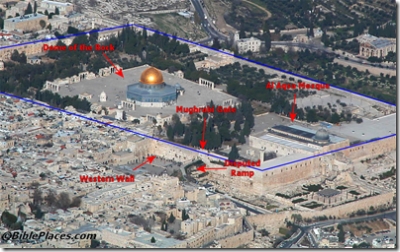Here’s a rule of thumb: if a news article touches on the Temple Mount or the City of David, you can pretty much count on large parts of it being politically motivated and inaccurate. A good example of that is yesterday’s Haaretz article by Meron Rapoport. Non-Israeli readers may not know of Haaretz’s reputation as the left-wing newspaper of the country. You can read the short article yourself; I’m going to limit myself to addressing the article’s failures.
1. The supervising archaeologists are Ronny Reich and Eli Shukrun. There is no Gabi Reich. That’s such a basic error that you know this reporter is completely unfamiliar with the subject. Reich is a first-rate archaeologist who has been an excavation director in Jerusalem for more than a decade and in other capacities since the early 1970s.
2. “This is a very sensitive region for a dig. Should it approach the Temple Mount wall, it will certainly elicit angry reactions from the Muslim Waqf…” The dig is in the City of David, many hundreds of meters from the Temple Mount. Ronny Reich has led excavations immediately next to the Temple Mount and there were no protests. For the record, Muslim protests are unrelated to reality. If some Muslim leader wants a reason to get his people worked up, he will claim his mosque is being undermined, even if last year’s dig was closer than this year’s. Given the context of the article, it appears that the author is trying to create a problem that does not exist. [Note that this excavation is completely separate from the dismantling and construction of a bridge for tourists to the Temple Mount, which was the stated reason for Muslim violence today.]
3. “Moreover, most of the excavation site is inhabited by Palestinians, and thus far, no effort has been made to get their permission, as required by law, for digging on and under their property.” There is no evidence that the author knows where the excavation really is. This is just an attempt to get somebody excited to shut down this dig. He certainly is unwilling to admit that the workers employed in these excavations are Palestinians who live in the area.
4. “But on top of all that” – is this really an appropriate phrase for a news article, or should this be on the editorial page?
5. The heart of the article concerns whether or not the excavators have a license to dig. “The excavation of a tunnel under Jerusalem’s City of David has gone on for months without a license from the Israel Antiquities Authority (IAA), as required by law.” This indeed is strange, given that the chief archaeologist on the ground (Shukrun) is an IAA employee. That means he does what he is told. If the IAA doesn’t grant him a license, then he’s not going to be digging there, assuming he wants to receive his salary.
6. The rat seems to be buried in the details. Possibly the issue is not the IAA not issuing a permit (even the article says, “the IAA decided to extend Reich and Shukrun’s license to dig in Silwan”), but the Israel Nature and National Parks Protection Authority (INNPPA) not giving permission to the IAA. Aha – this is a spat between governmental agencies. One is trying to control the other and when he doesn’t get his way, he calls his local journalist. I have no idea if the INNPPA really has authority over the IAA, but it really doesn’t matter to me. The issue is this “news article” and the dirty work that this journalist is willing to do.
7. “But INNPPA spokesman Moshe Gabay said that there is currently “no operative plan” to develop the area for tourism…” Well, this guy must live in Eilat. In the last couple of years, they’ve done extraordinary things in the City of David, including the excavation of the Pool of Siloam and opening it to tourists; the opening of the Siloam Tunnel to tourists; the construction of a visitor’s center at the entrance; the construction of a viewing point of the City of David; the excavation of the “palace of David” with attendant provisions for tourists. And just last week they drained Hezekiah’s Tunnel so that metal steps could be installed.
8. “nor did the organization [INPPA] approve an expanded dig. Instead, he said, it approved only an “exploratory dig” of 50 to 100 meters, after which a decision will be made.” So, what do you know? The INNPA actually did approve the dig.
The problem with articles like these is that they lead everyone astray except those closest to it. Thus, the esteemed Paleojudaica blog can conclude from the article, “there are irregularities with this dig which are a cause for concern.”
Back to the rule of thumb.

